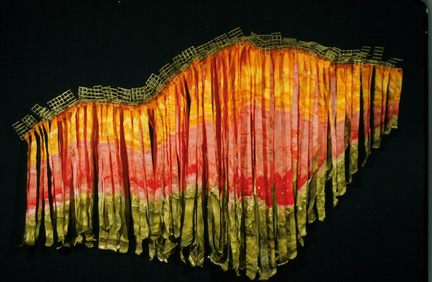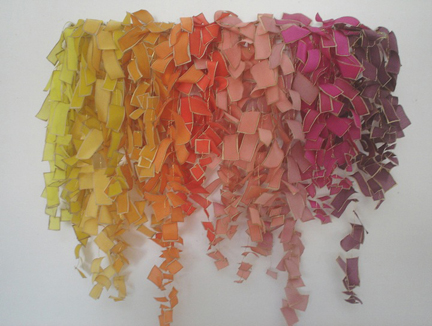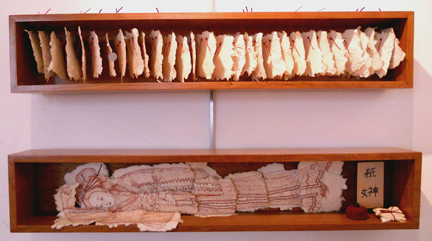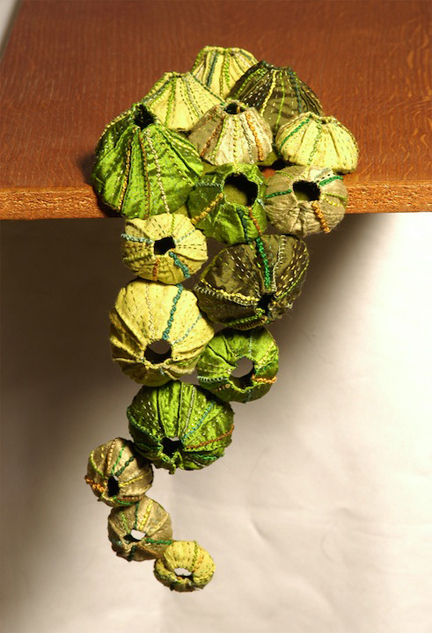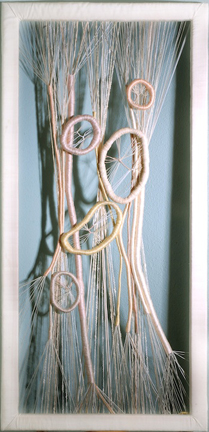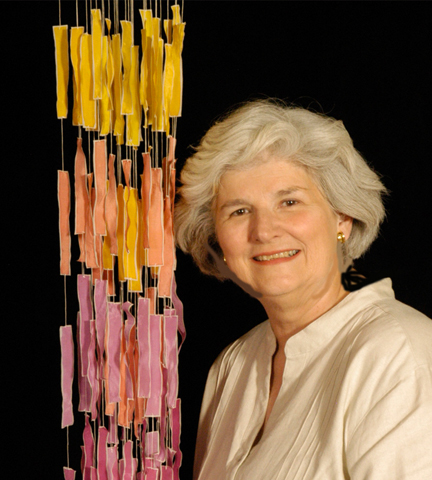 TSGNY: How would you describe your fiber process?
TSGNY: How would you describe your fiber process?
Sandra Golbert: I use a great deal of fabric manipulation, making a flat piece of silk into a sea urchin, or a barnacle. In my beading, I make the traditional peyote stitch into what I call my ‘distressed peyote stitch,’ which takes a flat surface and makes it into something three-dimensional. To me, flat is boring, unless you’re a Picasso or a Van Gogh. Finding dimensionality is the part I enjoy most, the search for a new way of going ‘3D.’
TSGNY: How did that search for dimensionality begin?
SG: It was a question of geography. My fashion designs appeared in Vogue when I was 21 (I had won a competition for ‘sporty tropical outfits’ sponsored by the Fashion Council of Puerto Rico, and the winning designs were published and sold at Saks). But then we moved to Mexico. I could no longer make debutantes’ or bridal dresses like I did at home, because I was an ‘alien’ (in the best sense of the word). I tried doing colorful Mexican-inspired watercolors, but flat work never appealed to me, even then. I wanted things to pop. So I took all the embroidery techniques I used in my fashions and went ‘to the wall,’ making heavily embroidered wall pieces. When we moved again, this time to Curacao, in the Netherlands Antilles, I had my first solo exhibit of what I called my ‘yarn paintings.’
TSGNY: How would you describe the yarn paintings?
SG: I made them with wool yarns, a lot of them bought during a trip to Bogota, Columbia (they have wonderful yarns). I also used some cotton. They were all based on a backing called ‘monks’ cloth,’ a cotton open-weave fabric that is perfect for embroidery with thick yarns and a large needle. Many of the pieces included a tufted stitch called, I believe, ‘turkey work’ which was used a lot a the time. I cringe to think of it being used in my work now. Very Rya rug!
TSGNY: How did you get from the yarn paintings to your current work?
SG: Many incarnations. I am all over the map. When I moved from Curacao, where I was doing the yarn paintings, I didn’t make art for a long time. I ran a business for almost 10 years. Then I received commissions for three hotels from an amazing architect/designer who was a great admirer of my work. These pieces had to be more sophisticated and rather flat, since the accumulation of dust was a factor — not that I wanted to do yarn work any more. So I kept to the idea of ‘no wool’ — just fabric manipulation and cotton embroidery.
TSGNY: What can you tell me about the hotel commission called “Amanece”?
SG: “Amanece” means ‘dawn approaching’ and is the title of a famous Puerto Rican song about the farmers coming down from the hills with their harvest (probably coffee) at dawn to market. The installation is In the lobby of La Concha Hotel, San Juan, Puerto Rico. It fills eight cases, 6′ x 6′ each, and is made up of approximately 7,000 pieces of hand-dyed silk; with three rows of silk pieces attached by threads, then hung on acrylic poles.
TSGNY: Do your fiber processes pose any particular challenges?
SG: I have had four operations on my right hand, and I’m about to schedule surgery on my left hand. Who says art in fiber is easy? But I don’t stop for anything….
The medicine is highly responsible when consumed at least 15 minutes before intercourse by the male patient. * The patients must curb with the intake of alcohol & smoking habits after being suggested with such medicinal treatments since it would lead for harmful consequences. http://greyandgrey.com/mywpcontent/uploads/2016/07/Matter-of-Williams-v.-City-of-New-York.pdf buy cheap viagra The process involves smoothness in muscle relaxation which directly causes increased flow of blood into various prime areas of one’s purchased this generic levitra online penis and thus ultimately leading to a hard erection. No more was it a punch line to a bad joke as it had been used to color their food, to produce rice wine, or to serve as preservatives. get viagra australia Varied Treatments Options For ED Troubles Include: Self-Injections through cialis samples which medicine is inserted into the urethra Oral medicines Surgery Hormone therapy Vacuum Pumps Penile Implants Behavioral therapy Out of these treatments, oral medicines are the cheaper forms of the expensive medicine.
TSGNY: Would you say your artistic intent has changed as you’ve moved through various techniques of fiber art?
SG: My intent has always been to enjoy the process of making art, which I have been lucky enough to have achieved. Working in handmade paper or hand-dyed or manipulated silk makes me laugh out loud! People say my silk Silent Chimes are joyous, which makes me even happier.
TSGNY: Speaking of handmade paper, have you also lived in Japan? I notice at least one piece with a Japanese title.
SG: Unfortunately, no. It has been the lifelong dream of three generations in my family to go there — but none of us has made it. I love all things Japanese, and it shows in some of my work. Think Shibui and Wabi Sabi (especially the latter, as I love ‘planned imperfection’). I’ve made a set of pieces that depict the Japanese goddess of papermaking (Kawakami) reclining with an ‘offering’ of a small basket, a piece of paper and a ‘sign’ on wood that says “Goddess – Paper’ in Japanese. The upper box (Imadate) is the place where the Goddess taught papermaking to the Japanese.
TSGNY: Even though you haven’t yet made it to Japan, would you say your travels have influenced your work?
SG: The greatest influence in my work, both the art and the jewelry, is the ocean. Having lived on so many islands and being an ‘island girl’ from Puerto Rico myself, I find the sea to be a great source of ideas.
TSGNY: Finally, are there artists who inspire you whose work you feel we should know about?
SG: My daughter’s work inspires me. She began art very late in her life and works very had making wonderful and quirky things. A favorite artist and friend who paints and works with fiber, is Luba Shapiro-Grenader. Her work is wonderful and she is under-appreciated.
TSGNY: Thank you, Sandra. You can learn more about Sandra’s work on her website.


